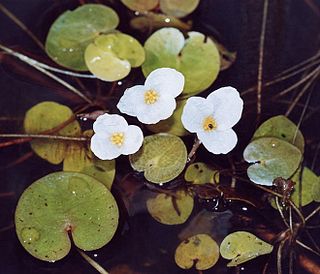
Hydrocharitaceae is a flowering plant family including 16 known genera with a total of ca 135 known species, that including a number of species of aquatic plant, for instance the tape-grasses, the well known Canadian waterweed, and frogbit.
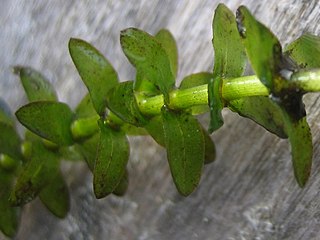
Elodea is a genus of 6 species of aquatic plants often called the waterweeds described as a genus in 1803. Classified in the frog’s-bit family (Hydrocharitaceae), Elodea is native to the Americas and is also widely used as aquarium vegetation and laboratory demonstrations of cellular activities. It lives in fresh water. An older name for this genus is Anacharis, which serves as a common name in North America.
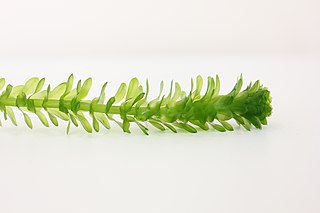
Egeria is a genus of three species of aquatic plants in the family Hydrocharitaceae described as a genus in 1849. native to warm-temperate South America.

Vallisneria is a genus of freshwater aquatic plant, commonly called eelgrass, tape grass or vallis. The genus is widely distributed in tropical and subtropical regions of Asia, Africa, Europe, and North America.

Stratiotes is a genus of submerged aquatic plant commonly known as water soldiers, described as a genus by Linnaeus in 1753. Several specific names have been coined within the genus, but at present only one is recognized: Stratiotes aloides. native to Europe and NW Asia.

Hyaenanche globosa is a species of plant under the family Picrodendraceae. It is the sole member of the genus Hyaenanche and the subtribe Hyaenanchinae. It is endemic to Cape Province in South Africa.
Apodiscus is a genus of trees belonging to the family Phyllanthaceae first described as a genus in 1912. It contains only one known species, Apodiscus chevalieri, native to tropical West Africa.
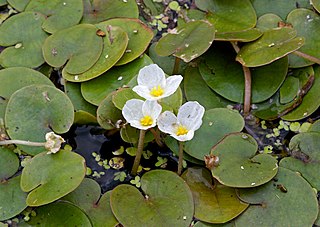
Hydrocharis is a genus of aquatic plants in the family Hydrocharitaceae described as a genus by Carl Linnaeus in 1753. It is widespread across much of Europe and Asia, plus a few scattered locations in Africa. It is also reportedly naturalized in parts of North America.

Najas, the water-nymphs or naiads, is a genus of aquatic plants. It is cosmopolitan in distribution, first described for modern science by Linnaeus in 1753. Until 1997, it was rarely placed in the Hydrocharitaceae, and was often taken as constituting the family Najadaceae.

Najas marina is a species of aquatic plant known by the common names spiny water nymph, spiny naiad and holly-leaved naiad. It is an extremely widespread species, reported across Europe, Asia, Africa, Australia, the Americas and many oceanic islands. It can be found in many types of freshwater and brackish aquatic habitat, including bodies of alkaline water.
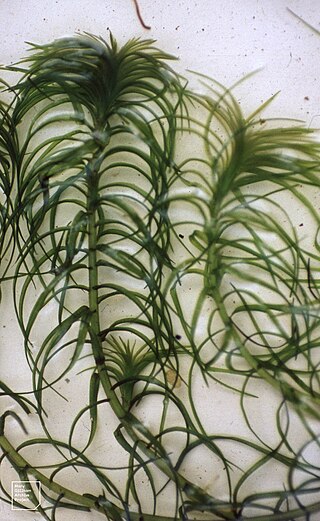
Lagarosiphon is a genus of aquatic plants described as a genus in 1841. It is native to Africa and Madagascar. It is dioecious, with male and female flowers produced on separate plants.
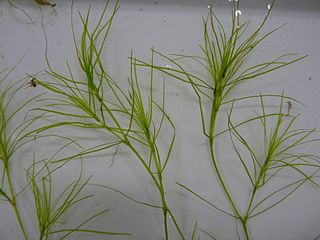
Najas graminea, also known as ricefield water-nymph is a species of aquatic plant found in freshwater habitats, especially still or slow-moving waters, like ponds and rice fields. It grows to a maximum length of 30 cm. The flowers are monoecious. The flowering season is from July to September.</ref>

Nechamandra is a monotypic genus of an aquatic plant family Hydrocharitaceae. The sole species is Nechamandra alternifolia. It is found in slow moving fresh water.

Blyxa is a genus of an aquatic plant of the family Hydrocharitaceae described as a genus in 1806.

Sagittaria australis, the Appalachian arrowhead or longbeak arrowhead, is a plant species native to much of the eastern part of the United States, from Louisiana to Iowa to New York State to Florida, mostly between New Jersey and Mississippi with scattered locations elsewhere in the range.

Blyxa aubertii, common name bamboo plant, is a plant species widespread across Asia, Europe, Africa and Australia, but known from the Western Hemisphere only from a few collections in the southwestern part of the US State of Louisiana. This is an aquatic plant growing in shallow lakes and ponds.
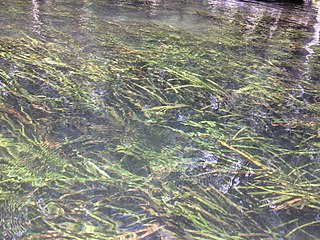
Sagittaria kurziana, common names springtape and strap-leaf sagittaria, is an aquatic plant species native to Florida and naturalized in the Mariana Islands. It grows along large springs, very often those with high sulfur content, and along the banks of watercourses downstream from such springs.

Limnobium, common names spongeplant and American frogbit, is a group of aquatic plants in the Hydrocharitaceae described as a genus in 1814. It is widespread in freshwater environments in Latin America, the West Indies, and the United States.

Maundia is a genus of alismatid monocots, described in 1858. Maundia was formerly included in the family Juncaginaceae but is now considered to form a family of its own under the name Maundiaceae. It contains only one known species, Maundia triglochinoides, endemic to Australia.

Hylodesmum glutinosum is a species of flowering plant in the family Fabaceae. Common names include large tick-trefoil, clustered-leaved tick-trefoil, large-flowered tick-clover, pointed tick-trefoil, beggar's lice and pointed-leaved tick-trefoil. It occurs in eastern Canada, the central and eastern United States, and northeastern Mexico.


















